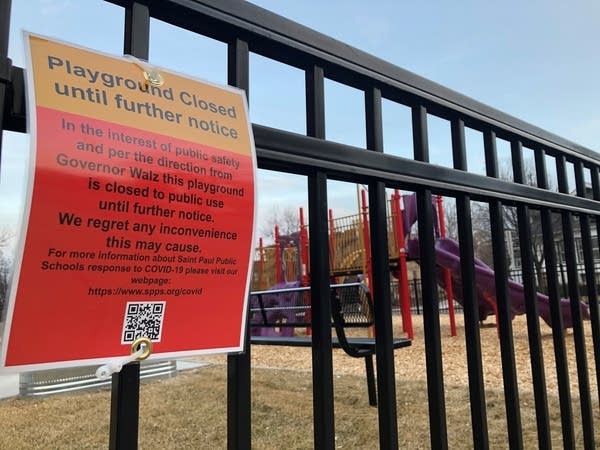Some playgrounds remain open, despite coronavirus worries. But are they safe?

Go Deeper.
Create an account or log in to save stories.
Like this?
Thanks for liking this story! We have added it to a list of your favorite stories.
Nearly a week into Minnesota’s stay-at-home order, Erik Cedarleaf Dahl has been surprised to see kids still playing on playground equipment in his north Minneapolis neighborhood.
Dahl has been keeping his own kids, ages 6 and 8, away from the playgrounds out of a concern that the coronavirus could linger on the equipment.
"Everything really feels unknown and uncertain,” Dahl said.
With the weather in Minnesota getting warmer, kids who have been cooped up inside just want to get out and play.
Turn Up Your Support
MPR News helps you turn down the noise and build shared understanding. Turn up your support for this public resource and keep trusted journalism accessible to all.
In some cities, playgrounds at public parks are closed in efforts to tamp down the spread of COVID-19, while in others, they remain open and busy. That's left many parents wondering whether they're safe.
Public health experts say the main way the new coronavirus is spread is through respiratory droplets, when an infected person coughs or sneezes, and another person close by inhales them. However, it’s also possible that a person can get COVID-19 by touching a surface that has the virus on it, then touching their own mouth, nose or eyes, according to the Centers for Disease Control and Prevention.
The stay-at-home order that took effect in Minnesota late last week, meant to encourage social distancing and keep people from congregating in large groups, didn't specifically require that public playgrounds close. That decision was left to individual cities, and they've taken different approaches across the state.
Some have fenced off playground equipment with caution tape. Others, like Minneapolis and Brainerd, Minn., have kept the structures open, but have posted signs advising people of the risks.
The science of how long the coronavirus can last on a surface is still unsettled. But most health experts would likely say Dahl is doing the right thing by keeping his kids away to help prevent the spread of COVID-19.
Playgrounds present unique challenges: Social distancing isn't exactly a concept that toddlers or preschoolers understand. Keeping them at least 6 feet apart while they're sliding on a slide or climbing on equipment is virtually impossible.

"The intention of a playground is for interaction, and we're trying to avoid that at this point,” said Dr. George Morris, medical incident commander for CentraCare’s COVID-19 response team.
Morris said it’s still unclear how long the virus can live on a surface. Some studies have suggested it can survive for hours — or even days — on plastic or metal. And playgrounds aren't sanitized on a regular basis, if ever.
"One child is touching a swing or playing on a slide with their hands and then the next child comes down, gets exposed to it,” Morris said. “They're always touching their face, and so there would be that risk of exposure that way."
That risk led the Twin Cities suburb of Eden Prairie to close its playgrounds earlier this week. The city’s Parks and Recreation Director Jay Lotthammer said people were still using the city's playgrounds last weekend, as the stay-at-home order went into effect.
"We really felt that erring on the side of caution at this point would be something that would be good for us to do," Lotthammer said.
Some city leaders are sending an even more direct message. During his weekly COVID-19 briefing, Moorhead, Minn., Mayor Johnathan Judd urged residents to use city parks and walkways to get some fresh air, but implored children and adults to stay off the playground equipment. He urged people to be the "neighborhood parent" and get involved, if needed.
"If you see children that are doing things that they should not be doing, don't be afraid to call them out and get them to act right,” Judd said.

In the meantime, many Minnesotans are finding ways to get outside and use parks and trails, while still maintaining social distance — by hiking, biking or playing outdoor games as a family. Health experts say it's more important than ever to stay active and be outside as much as possible to stay physically and mentally healthy.
"We know outdoors and play is still important, especially at this time of stress and change,” Morris said. “We just want it to be in small, family groups, in settings that are safer."
Dayna Grams of Champlin has been following that advice with her three kids, who range in age from 7 months to 8 years old. Instead of the playground, Grams said her family has been going on bike rides or playing in the yard.
"We built a fort in the backyard,” she said. “We've been striving to create ways for them to get their energy out within our space."
MPR News reporter Dan Gunderson contributed to this report.
COVID-19 in Minnesota
Health officials for weeks have been increasingly raising the alarm over the spread of the novel coronavirus in the United States. The disease is transmitted through respiratory droplets, coughs and sneezes, similar to the way the flu can spread.
Government and medical leaders are urging people to wash their hands frequently and well, refrain from touching their faces, cover their coughs, disinfect surfaces and avoid large crowds, all in an effort to curb the virus’ rapid spread.
The state of Minnesota has temporarily closed schools, while administrators work to determine next steps, and is requiring a temporary closure of all in-person dining at restaurants, bars and coffee shops, as well as theaters, gyms, yoga studios and other spaces in which people congregate in close proximity.


